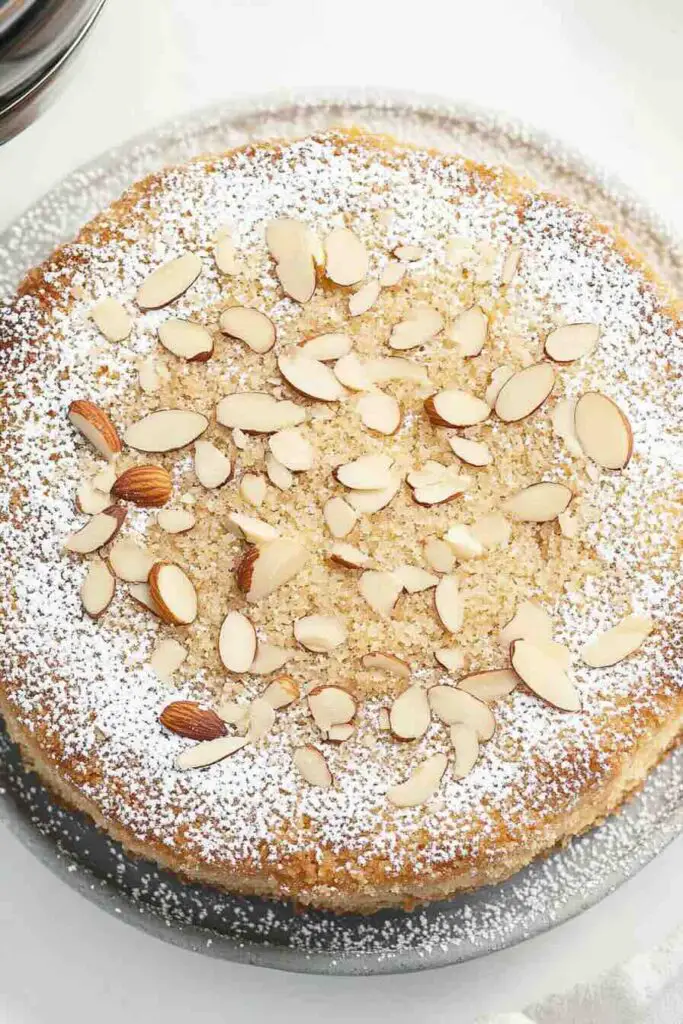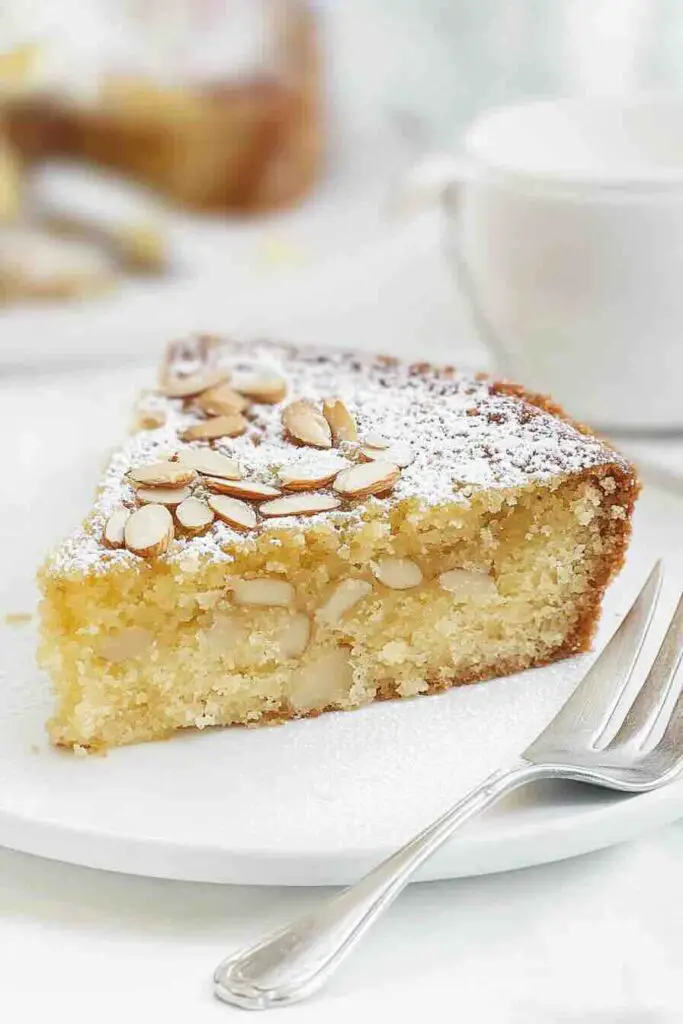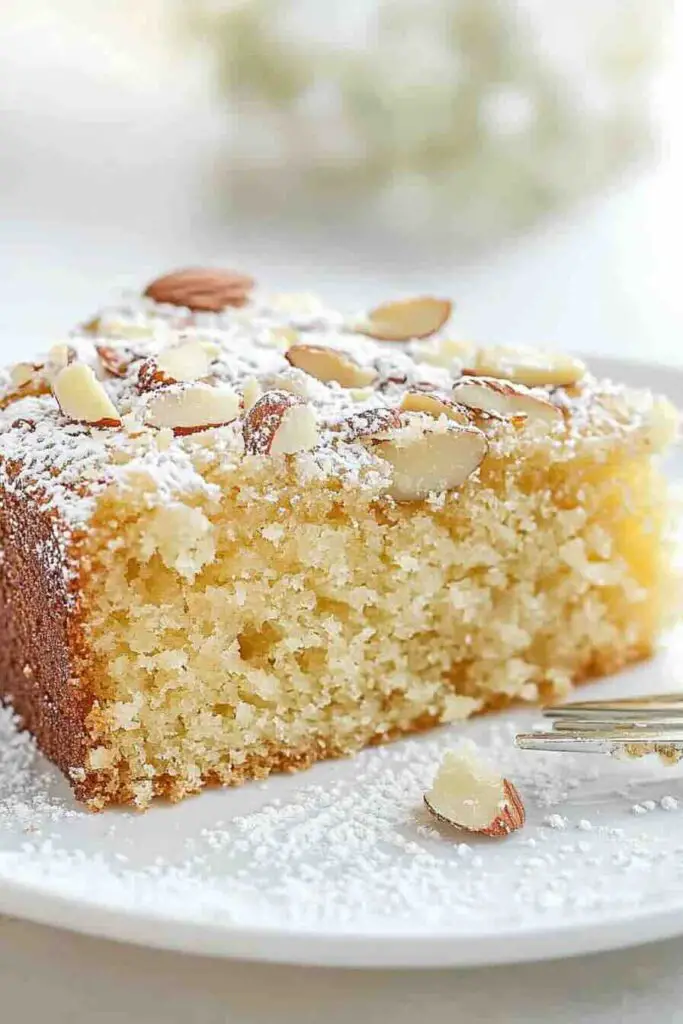The Buttery, Nutty, Absolutely Scrumptious Classic You NEED to Bake
Alright, folks—let’s talk about ALMOND CAKE! This isn’t just any cake. It’s rich, it’s buttery, it’s got that deep, nutty almond flavor that makes you close your eyes and go “Mmmm…” after every bite. Whether you’re a cake lover (same!) or someone who just appreciates a slice of something special with their afternoon coffee, this recipe is about to become your new favorite.
But wait—there’s more! This cake has history, variations from around the world, and a texture that’s both moist and perfectly dense. Plus, it’s EASY. No fussy layers, no complicated techniques—just a foolproof, delicious treat that delivers every single time.
So, why should you make this cake? Oh, let me count the ways…

Reasons You’ll Love Almond Cake
1. The Texture is Out of This World
We’re talking soft, slightly dense, and oh-so-moist. No dry, crumbly nonsense here—just that perfect balance of tenderness and structure.
2. Simple Ingredients, BIG Flavor
You don’t need a laundry list of fancy ingredients. Just some pantry staples, a little almond magic, and BOOM—dessert perfection.
3. It’s a No-Fuss, No-Fail Recipe
If you can mix things in a bowl and pour batter into a pan, you can make this cake. It’s truly that easy!
4. It Works for ANY Occasion
Brunch? Check. Tea time? Yup. Fancy dinner party? Absolutely. Midnight snack? Say no more.
5. You Can Dress It Up or Keep It Simple
Serve it plain with a dusting of powdered sugar or go wild with glazes, toppings, and fillings. (Chocolate drizzle, anyone?!)
What Makes a Good Almond Cake?
Before we dive into the recipe, let’s talk about what separates a “meh” almond cake from a truly spectacular one.
Key Characteristics of a Great Almond Cake
Balanced Almond Flavor
A great almond cake doesn’t just whisper “almonds” to you—it sings it loud and proud! The secret? A perfect blend of almond paste, almond extract, and sometimes even a sprinkle of sliced almonds on top.
Moist Yet Firm Texture
Dry cakes are a crime. (Okay, maybe not legally, but still.) The right fat-to-flour ratio ensures a moist, tender crumb while keeping everything structurally sound.
Golden-Brown Crust
That slightly crispy, caramelized edge? Yeah, that’s the good stuff. It gives contrast to the soft, rich interior.
Not Too Sweet
Almond cakes are all about the nutty, buttery goodness. The sugar should complement, not overpower.
Toppings? Yes, Please!
A dusting of powdered sugar? A drizzle of almond glaze? Toasted almonds? Any of these will take your cake to the next level.
Common Mistakes to Avoid
Overmixing the Batter – This is a one-way ticket to Dense Cake Town. Mix just until combined.
Using Stale Almonds – Old almonds taste bitter and sad. Fresh is best!
Skipping the Parchment Paper – Unless you enjoy cakes that refuse to leave their pan, line that thing!
The Cultural Significance of Almond Cake
This cake isn’t just a treat—it’s a global star! From Europe to the Middle East, almond-based cakes pop up in countless traditions.
A Global Favorite
Almond cakes have been baked for centuries, popping up at celebrations, religious festivals, and everyday coffee breaks.
Regional Variations
Swedish Almond Cake – Light, buttery, perfect with a cup of coffee.
🇪🇸 Tarta de Santiago – Spanish almond cake, gluten-free, and topped with powdered sugar.
🇫🇷 Financier – Little almond cakes, rich and buttery, popular in French bakeries.
🇮🇹 Torta di Mandorle – A rustic Italian almond cake with a beautifully coarse texture.
History of Almond Cake
Almond cake has been around for AGES—literally.
Ancient Origins
Almonds were used in baking way back in ancient Egypt, often in honeyed sweets reserved for royalty.
Medieval Influence
When the spice trade flourished, almonds became a staple in European baking, showing up in fancy cakes served at feasts.
Modern Popularity
Today, almond cakes are a staple in bakeries and home kitchens worldwide, thanks to their simple yet sophisticated flavor.
Ingredients
Here’s everything you need for the BEST almond cake ever:
- Almond Paste – The secret to that deep, authentic flavor.
- All-Purpose Flour – Just enough to give structure.
- Butter – Adds moisture and richness.
- Eggs – For binding and a little lift.
- Baking Powder – Helps with that light rise.
- Granulated Sugar – Sweet, but not too sweet.
- Kosher Salt – Balances all the flavors.
- Almond Extract – Gives it that extra almondy kick.
- Sliced Almonds – For texture and a pretty finish.
Optional additions: Lemon zest for freshness, a drizzle of honey, or a splash of vanilla extract.
Instructions
Here’s how you whip up this almondy masterpiece:
Preheat & Prep – Heat your oven to 325°F. Line a 9-inch pan with parchment and grease it well.
Mix Dry Ingredients – Whisk together flour, baking powder, and salt.
Cream Almond Paste & Sugar – Beat together until crumbly, then mix in butter until fluffy.
Add Eggs & Extract – One egg at a time, mixing well. Stir in almond extract.
Combine & Bake – Gently fold in dry ingredients, pour into the pan, sprinkle with sliced almonds, and bake for 45-50 minutes.
Cool & Serve – Let it cool completely, then dust with powdered sugar or drizzle with glaze.
How to Tell When Almond Cake Is Done
One of the most important steps in baking any cake is knowing exactly when it is done. An underbaked almond cake can be too soft and dense in the center, while an overbaked one can turn dry and crumbly. Since almond cake is naturally rich and moist, getting the bake just right is key to achieving that perfect balance of texture and flavor.
A simple way to determine if your almond cake is fully baked is the toothpick test. Insert a clean toothpick or a thin skewer into the center of the cake. If it comes out with a few moist crumbs but no wet batter, your cake is ready. in case the toothpick is completely dry, your cake might have baked a little too long. If wet batter sticks to the toothpick, it needs more time in the oven.
Another indicator of doneness is the golden-brown color. Almond cake typically develops a lightly golden or slightly darker crust as it bakes. The top should have a slight sheen and feel firm to the touch, but it should not look pale or remain doughy. If your cake is browning too quickly before the inside is fully cooked, loosely cover it with aluminum foil and continue baking.
Lastly, allow the cake to cool in the pan for about 10 to 15 minutes before transferring it to a wire rack. This resting time helps the cake set properly and prevents it from breaking apart when removed from the pan. Once cooled, it will continue to firm up slightly, making slicing easier and allowing the flavors to develop even more.

Variations & Toppings
Almond cake is a wonderfully versatile dessert, offering endless possibilities for flavor customizations and decorative toppings. Whether you prefer a classic approach or enjoy experimenting with new combinations, there are many ways to make this cake uniquely your own.
Flavor Variations
One of the easiest ways to modify the flavor of almond cake is by incorporating additional ingredients that complement its natural nuttiness. Citrus lovers can add freshly grated lemon, orange, or even lime zest to the batter, giving the cake a refreshing brightness. A small amount of citrus juice can also enhance the overall taste without overpowering the almonds.
For a more decadent version, chocolate almond cake is an excellent choice. You can add cocoa powder or melted dark chocolate to the batter, creating a rich and indulgent variation. If you prefer a more subtle chocolate presence, consider folding in chocolate chips for little bursts of sweetness in every bite.
If you enjoy warm spices, adding a pinch of cinnamon, cardamom, or nutmeg can introduce a comforting depth to the cake. These spices work exceptionally well in colder months, making almond cake a perfect seasonal treat.
Topping Ideas
The right topping can elevate an almond cake from simple to spectacular. A dusting of powdered sugar is one of the easiest and most traditional finishing touches. It adds a delicate sweetness while maintaining the cake’s rustic charm.
For those who enjoy a bit of crunch, toasted sliced almonds sprinkled over the top before baking create a beautiful golden layer. This not only enhances the presentation but also adds a satisfying texture.
If you prefer a more elegant look, an almond glaze made from powdered sugar, almond extract, and a splash of milk can be drizzled over the cooled cake. This light glaze seeps into the cake slightly, adding extra moisture and flavor without overwhelming the delicate almond taste.
No matter how you customize it, almond cake is a versatile dessert that can be tailored to suit any preference or occasion.
Nutritional Insights
Almond cake is not just delicious—it also offers some notable nutritional benefits, particularly due to its almond content. Almonds are known for being rich in healthy fats, protein, fiber, and essential vitamins and minerals. When incorporated into a cake, they contribute to a dessert that is both flavorful and slightly more nutritious than traditional butter-based cakes.
A single serving of almond cake typically contains between 350 to 450 calories, depending on the ingredients used. The majority of these calories come from healthy monounsaturated fats, which support heart health and help keep you feeling full for longer.
Almonds are an excellent source of vitamin E, an antioxidant that helps protect cells from damage and supports healthy skin. Additionally, they contain magnesium and potassium, two minerals that contribute to proper muscle function and overall well-being.
While almond cake does contain sugar, it is generally lower in sugar than many frosted or heavily sweetened cakes. You can also experiment with using natural sweeteners, such as honey or maple syrup, to create a slightly healthier version.
For those who are gluten-sensitive, almond cake can easily be adapted by replacing traditional flour with almond flour. This not only makes the cake naturally gluten-free but also increases its protein and fiber content, making it a more filling option.
Pro Tips & Tricks
Baking the perfect almond cake comes down to a few key techniques that ensure the best possible flavor and texture. Here are some expert tips to help you achieve consistent results every time.
- Use Fresh Almonds or Almond Paste – Since almonds are the star ingredient, always use fresh, high-quality nuts or paste to get the best flavor. Stale almonds can taste bitter and affect the overall quality of the cake.
- Bring Ingredients to Room Temperature – Cold butter, eggs, or milk can create an uneven batter. Allowing ingredients to reach room temperature ensures a smoother mixing process and a more uniform cake.
- Do Not Overmix the Batter – Overworking the batter can result in a dense, tough cake. Mix only until the ingredients are combined to maintain a light, tender texture.
- Let the Cake Cool Completely – Almond cake develops its best flavor after it has cooled. Allow it to rest before slicing, as this helps the structure set properly and improves the overall taste.
- Toast Almonds Before Using – If you’re adding sliced almonds to the top, lightly toasting them beforehand enhances their flavor and provides an even crunchier texture.
Storage & Health Tips
To keep your almond cake fresh and delicious, proper storage is essential. When stored correctly, almond cake can retain its moisture and flavor for several days.
At room temperature, almond cake can be kept in an airtight container for two to three days. Make sure to store it in a cool, dry place away from direct sunlight.
If you need to store it for a longer period, refrigerating the cake is a great option. In the refrigerator, almond cake stays fresh for up to a week. However, keep in mind that refrigeration can sometimes dry out cakes, so it’s best to wrap it tightly in plastic wrap or store it in an airtight container.
For longer storage, almond cake can be frozen for up to three months. Wrap individual slices or the whole cake in plastic wrap, then place them in a freezer-safe bag or container. When ready to eat, allow the cake to thaw at room temperature for a few hours.
For a healthier take on almond cake, consider using whole wheat flour or almond flour, reducing sugar, or incorporating natural sweeteners. These adjustments can make the cake slightly more nutritious while maintaining its delicious taste.

FAQs About Almond Cake
What makes almond cake different from regular cake?
Almond cake has a distinct nutty flavor, a slightly denser texture, and a richer taste due to the use of almond paste or almond flour.
Can I make almond cake gluten-free?
Yes! By substituting all-purpose flour with almond flour or a gluten-free flour blend, you can make a delicious gluten-free version.
Can I add chocolate to almond cake?
Absolutely. You can mix in cocoa powder, melted chocolate, or chocolate chips for a chocolate-almond twist.
What is the best way to serve almond cake?
It pairs beautifully with coffee, tea, fresh berries, whipped cream, or a dusting of powdered sugar.
Before You Go…
Now, tell me—are you baking this ASAP? Because you totally should. When you do, let me know how it turns out! Snap a pic, leave a comment. and if you’re craving more goodness? Check out my recipe for French Lemon Tart next. It’s just as comforting, indulgent, and easy to make. You’re going to love it! ❤️

Almond Cake Recipe
- Prep Time: 15 minutes
- Cook Time: 45 minutes
- Total Time: 1 hour
- Yield: 8–10 slices 1x
Description
This almond cake recipe is rich, moist, and full of nutty goodness! Made with almond paste and simple pantry ingredients, it’s easy to whip up and perfect for any occasion. Whether you enjoy it plain, dusted with powdered sugar, or topped with fresh berries, this cake is guaranteed to impress. Serve it with a cup of coffee or tea for a delightful treat!
Ingredients
Cake Batter:
- 1 ¼ cups (150g) all-purpose flour
- 1 teaspoon baking powder
- ¼ teaspoon salt
- 7 ounces (200g) almond paste, crumbled
- ¾ cup (150g) granulated sugar
- ½ cup (115g) unsalted butter, softened
- 3 large eggs, room temperature
- ½ teaspoon almond extract
- ½ cup (120ml) whole milk
- ½ cup (50g) sliced almonds (for topping)
Optional Toppings:
- Powdered sugar (for dusting)
- Almond glaze (powdered sugar, almond extract, and milk)
- Fresh berries (strawberries, raspberries, or blueberries)
Instructions
- Preheat & Prepare the Pan
- Preheat oven to 325°F (163°C).
- Grease a 9-inch round cake pan and line the bottom with parchment paper.
- Mix Dry Ingredients
- In a medium bowl, whisk together flour, baking powder, and salt. Set aside.
- Cream Almond Paste & Sugar
- In a large mixing bowl, beat almond paste and sugar until crumbly.
- Add butter and beat until light and fluffy.
- Incorporate Eggs & Almond Extract
- Add eggs one at a time, mixing well after each addition.
- Stir in almond extract for extra nutty flavor.
- Combine Dry & Wet Ingredients
- Gradually add the dry ingredients, alternating with milk, mixing until just combined. Do not overmix.
- Bake the Cake
- Pour batter into the prepared pan and smooth the top.
- Sprinkle with sliced almonds.
- Bake for 45-50 minutes, or until a toothpick inserted in the center comes out with a few moist crumbs.
- Cool & Serve
- Let the cake cool in the pan for 10-15 minutes, then transfer to a wire rack to cool completely.
- Dust with powdered sugar or drizzle with almond glaze before serving.
Notes
- For a gluten-free version, substitute all-purpose flour with almond flour or a gluten-free blend.
- To enhance the flavor, toast the sliced almonds before adding them to the batter.
- If using almond flour instead of almond paste, increase butter to ¾ cup (170g) for extra moisture.
- Storing leftovers: Keep at room temperature for 2-3 days or refrigerate for up to a week. Wrap well to prevent drying out.
- Freezing instructions: Wrap slices in plastic wrap and store in an airtight container. Thaw at room temperature before serving.
Nutrition
- Calories: 402
- Sugar: 22g
- Sodium: 105mg
- Fat: 24g
- Saturated Fat: 9g
- Carbohydrates: 40g
- Fiber: 2g
- Protein: 8g
- Cholesterol: 85mg
